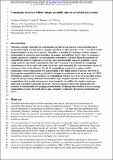| dc.contributor.author | Friedman, Jonathan | |
| dc.contributor.author | Higgins, Logan M. | |
| dc.contributor.author | Gore, Jeff | |
| dc.date.accessioned | 2019-11-25T19:07:00Z | |
| dc.date.available | 2019-11-25T19:07:00Z | |
| dc.date.issued | 2017-03 | |
| dc.date.submitted | 2016-08 | |
| dc.identifier.issn | 2397-334X | |
| dc.identifier.uri | https://hdl.handle.net/1721.1/123084 | |
| dc.description.abstract | Microorganisms typically form diverse communities of interacting species, whose activities have tremendous impact on the plants, animals and humans they associate with. The ability to predict the structure of these complex communities is crucial to understanding and managing them. Here, we propose a simple, qualitative assembly rule that predicts community structure from the outcomes of competitions between small sets of species, and experimentally assess its predictive power using synthetic microbial communities composed of up to eight soil bacterial species. Nearly all competitions resulted in a unique, stable community, whose composition was independent of the initial species fractions. Survival in three-species competitions was predicted by the pairwise outcomes with an accuracy of ~90%. Obtaining a similar level of accuracy in competitions between sets of seven or all eight species required incorporating additional information regarding the outcomes of the three-species competitions. Our results demonstrate experimentally the ability of a simple bottom-up approach to predict community structure. Such an approach is key for anticipating the response of communities to changing environments, designing interventions to steer existing communities to more desirable states and, ultimately, rationally designing communities de novo. | en_US |
| dc.description.sponsorship | United States. Defense Advanced Research Projects Agency | en_US |
| dc.description.sponsorship | National Institutes of Health (U.S.) (New Innovator Award NIH DP2) | en_US |
| dc.description.sponsorship | National Science Foundation (U.S.) (CAREER Award) | en_US |
| dc.description.sponsorship | Paul G. Allen Frontiers Group (Allen Investigator Program) | en_US |
| dc.description.sponsorship | Alfred P. Sloan Foundation (Sloan Research Fellowship) | en_US |
| dc.description.sponsorship | Pew Charitable Trusts (Pew Scholars Program) | en_US |
| dc.publisher | Springer Science and Business Media LLC | en_US |
| dc.relation.isversionof | http://dx.doi.org/10.1038/s41559-017-0109 | en_US |
| dc.rights | Creative Commons Attribution-Noncommercial-Share Alike | en_US |
| dc.rights.uri | http://creativecommons.org/licenses/by-nc-sa/4.0/ | en_US |
| dc.source | bioRxiv | en_US |
| dc.title | Community structure follows simple assembly rules in microbial microcosms | en_US |
| dc.type | Article | en_US |
| dc.identifier.citation | Friedman, Jonathan, et al. “Community Structure Follows Simple Assembly Rules in Microbial Microcosms.” Nature Ecology & Evolution 1, 5 (March 2017): 0109 © 2017 Macmillan Publishers Limited, part of Springer Nature | en_US |
| dc.contributor.department | Massachusetts Institute of Technology. Microbiology Graduate Program | en_US |
| dc.contributor.department | Massachusetts Institute of Technology. Department of Physics | en_US |
| dc.relation.journal | Nature Ecology & Evolution | en_US |
| dc.eprint.version | Original manuscript | en_US |
| dc.type.uri | http://purl.org/eprint/type/JournalArticle | en_US |
| eprint.status | http://purl.org/eprint/status/NonPeerReviewed | en_US |
| dc.date.updated | 2019-03-25T16:36:32Z | |
| dspace.orderedauthors | Friedman, Jonathan; Higgins, Logan M.; Gore, Jeff | en_US |
| dspace.embargo.terms | N | en_US |
| dspace.date.submission | 2019-04-04T11:11:29Z | |
| mit.journal.volume | 1 | en_US |
| mit.journal.issue | 5 | en_US |
| mit.license | OPEN_ACCESS_POLICY | en_US |
